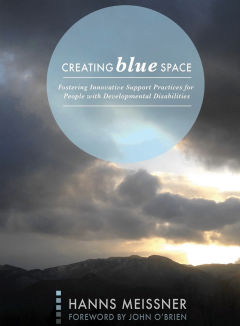The journey from institutional services to individualised housing and support.
Review of Creating Blue Space: Fostering innovative support practices for people with developmental disabilities
Author: Hanns Meissner
Reviewed by: David Towell
In agencies that provide direct support to disabled people seeking to live their lives to the full, Hanns Meissner writes, ‘each conversation holds the potential to move us closer to supporting people as citizens as opposed to caring for the clients of a system’.

In almost all economically rich countries, there has been a more-or-less common history over the past half century in the lives led by disabled people, especially people with learning disabilities, and the support available to them - most simply described in terms of the shift from segregated institutions to community living. Of course this has by no means been a linear transformation, nor is it complete: indeed as we see in the UK, some of the hard-won gains driven by the 'An Ordinary Life' movement are increasingly at risk in the face of social division and austerity.
I have previously reviewed John O'Brien and Beth Mount's excellent book Pathfinders (sub-title People with developmental disabilities and their allies building communities that work for everyone). This book starts from the perspective of people with disabilities (the 'Pathfinders' of the title) and shows what they can achieve in their own lives and also in everybody's when:
Creating Blue Space is very much in harmony with this approach: indeed O'Brien provides a Foreword and Mount has been a consulting colleague with Meissner. However the distinctive and very valuable contribution of this book is that it explores in detail what it means for service providing organisations to transform their practice towards offering individualised supports that enable disabled people to take their rightful place as contributing citizens in their communities.
The Arc of Rensselaer County (R-Arc) in New York State was created sixty years ago by parents seeking to ensure that better options were available for their own disabled children. This pattern of parent leadership in initiating community services is also common across countries. Over time, such agencies have both grown and become increasingly dependent on funding from the state, with all that means for both securing and extending services and for the need to adapt to public policy and tight regulation. Meissner joined R-Arc in 1979 as the Director of Vocational Services and later became Chief Executive, thus living much of the lengthy learning journey which has produced the R-Arc of today.
This is the best account I have found of what it takes to achieve service transformation through innovating with and around individuals and their circles of support so as to break new ground in what genuine community living requires. Moreover the text includes a detailed Workbook and set of tools designed to assist organisational leaders elsewhere make their own learning journey to inclusive practice.

Beth Mount's 'Keys To Life' quilt expresses the spirit of innovation required to create individualised housing and support in the community.
How were these transformational changes achieved? From its origins, R-Arc had a leadership which understood that human service organisations need to promote positive relationships among their staff, the people they support and other stakeholders; it also developed a culture which fosters innovation. Increasingly this leadership recognised that progress towards individualisation and community participation required deep changes not only in existing practices but also in the ways of achieving change.
Significantly here, Meissner became an organisational development practitioner and, with external support, employed a range of O.D. methods (Future Search, Open Space, Appreciative Inquiry, World Café etc) in seeking to develop R-Arc as a learning organisation.
More recently these efforts have drawn particularly on the theory of individual and organisational learning developed by Otto Scharmer, 'Theory U'. This approach recognises that transformational change cannot be built on what came before through rational and incremental improvements; rather it requires that we disrupt the past in order to discover something new. The 'U' represents the shape of this process, involving in this context:
The 'blue space' of the book's title comes from the metaphor of the storm where there is calmness at the centre even as the elements rage all around. In our work we need to create the 'blue space' in which we can find the peace to honestly assess current reality and generate the changes in self, relationships and organisation which better meet our highest ideals.
The Workbook encourages us to follow the 'U' path in our own efforts to promote transformative innovation.
This rich and illuminating story offers lessons for all of us seeking to advance value-driven innovation. Developing new forms of support which better enable disabled people to live their own lives as part of the community requires fresh thinking and deeper relationships with people and their families. Organisations providing support need to develop their capacities to simultaneously manage both change and stability within a policy environment which often favours the latter. Creative innovation emerges most productively in blue space which facilitates co-production among an increasing variety of relevant stakeholders. We are all potential leaders in the journey to promote equal citizenship.
The publisher is Inclusion Press. Creating Blue Space © Hanns Meissner 2013.
Review: Creating Blue Space © David Towell 2019.